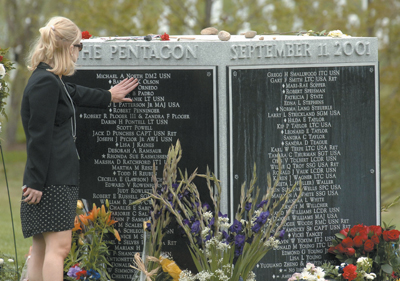Following a business trip to the East Coast 10 years ago,
Suzanne Calley headed home to San Martin on board American Airlines
Flight 77. Her plane was scheduled to land in Los Angeles, where
Calley would board a connecting flight to San Jose.
Following a business trip to the East Coast 10 years ago, Suzanne Calley headed home to San Martin on board American Airlines Flight 77. Her plane was scheduled to land in Los Angeles, where Calley would board a connecting flight to San Jose.
Her husband, Frank Jensen, would be waiting.
“But they shut down the whole airport,” he said.
So Jensen went home. He looked up his wife’s ticket number. He called American Airlines.
Three to four hours later, a representative officially confirmed the grim reality.
“Yes, her ticket was on board. Yes, she boarded.”
Two years after that fateful day when Calley, 42, perished Sept. 11 alongside 184 victims at the Pentagon site, Jensen cremated his wife’s body. Her remains were first pulled by rescue crews from the twisted wreckage of Flight 77, and later scattered by Jensen into the Pacific Ocean near Monterey. This is where the couple frequently taught classes together as master scuba instructors.
In waning years after Calley’s passing, one perspective rings crisp in Jensen’s reflections as he speaks candidly about the ordeal during a recent phone conversation.
“I’ve had time to realize Suzanne was not the only one who got lost,” he said.
This follows a maelstrom of “all kinds of emotions and anger” Jensen grappled with as he contemplated the acts of terrorism that killed 2,983 victims in the 9/11 attacks. The widower said he was consumed with questions of “how something like this could happen.”
“You kind of want somebody to pay for what happened at some point,” said Jensen, who admitted much of his fury was “certainly” directed toward Bin Laden. “But you realize that doesn’t bring her back or change anything.”
A manager of strategic alliances for Cisco Systems in San Jose, Calley was 42 years old when terrorists hijacked the plane she was on and sent it crashing into the western side of the Pentagon. She had planned on celebrating her 20th anniversary Sept. 17 with Jensen when she returned home to San Martin, followed by her 43rd birthday a few days later.
Jensen, a Gilroy native who was born in the historic Wheeler Hospital on Sixth Street, met his future wife at Pacific Stereo in San Jose “at a computer training class for the Atari 400,” he laughed, remarking on the now outdated personal computer manufactured in the late 1970s.
The pair eventually interviewed for the same assistant manager job – which Jensen got.
Calley wasn’t one to bare any grudges, apparently, as the two later married.
The couple didn’t have any children, but fawned over a duo of Labrador retrievers named Hershey and Bandit “that were basically our kids,” Jensen said.
Every time he dotes on his dogs, Jensen says the action still elicits sweet memories.
A memorial bench for Calley now sits in Lover’s Cove on the Monterey Peninsula, overlooking the same bay where the couple spent countless hours scuba diving. Engrained into the wood reads, “Suzanne Marie Calley, 9/17/57-9/11/01, dedicated to the victims and those touched by the events of 9/11/01.”
As the 10th anniversary of 9/11 approaches, Jensen said he plans to visit to the spot.
Calley’s mother, Norma Keleher, lives nearby in Pacific Grove.
After Sept. 11, 2001
Jensen since remarried in 2004, and moved from San Martin in 2009 for a fresh start elsewhere in Northern California where he works as a pilot.
He has visited the Pentagon in Arlington, Va. on three occasions – one month, one year and three years after the attacks. While Jensen did not attend the opening of the 2008 Pentagon Memorial Park, which boasts 184 metal benches bearing the names of each victim that perished at that site, he said a friend who attended estimates 90,000 people turned out for the occasion.
During large-scale public gatherings such as this, Jensen said it’s difficult to not become weary getting asked the same questions “47 times by 47 different newspapers.”
A decade after the disaster, journalists calling his home and cell phone still “come out of the woodwork,” Jensen said.
One question Jensen still struggles to answer is his reaction to American forces killing Osama Bin Laden on May 2 in Pakistan this year. He’s has been asked the question on numerous occasions, but an encompassing answer doesn’t manifest automatically, Jensen said.
“You want to say, ‘relief,'” he said, pausing in a moment of thought. “But that’s not really it … I’m certainly glad; it’s a little bit of closure, I guess. Closure to a degree.”
Alluding to psychological elements that can only evolve with time – understanding, perspective, outlook, healing, retrospect – Jensen added, “had it happened significantly sooner, I think it would have had a different impact than it does almost 10 years later.”
Mentally blocking himself from processing the gritty logistics, Jensen said, became a personal coping mechanism.
“You know she was on the plane. You know it hit the Pentagon. You know she died. I had friends who wanted to read forensic autopsies,” said Jensen. “The plane was going 600 miles an hour and it hit a wall. You don’t need data to know what transpired. Getting into details doesn’t help.”
In the first year after the attacks, Jensen said he had no desire to discuss his wife’s “very surreal” death..
As time passes, “you start discussing it with people,” Jensen said.
What does open old wounds, occasionally, are the conspiracy theorists claiming 9/11 was a government-arranged hoax.
This kind of talk blows him away, Jensen said.
He recalls standing in a Hallmark store several years ago, catching wind of a conversation between a pair of teenage boys who said 9/11 “didn’t really happen.'”
“You overhear this stuff and go, ‘Wow. Did we really forget that much already?'” Jensen said.
After a certain phone conversation with a reporter in 2002, Jensen believes it was actually an investigative reporter with ulterior motives.
When Jensen shared his account of receiving Calley’s wedding ring and driver’s license – items recovered at the crash site and later returned to him – this information was utilized as fodder to feed a dubious online narrative scoffing the legitimacy of 9/11.
Titled “Still More Miraculous 911 Evidence Found,” the article remains active online.
“I was there at the Pentagon for the one-month anniversary,” said Jensen. “I stood and saw the hole in the wall.”
Chaplain Jim Uhey, a national disaster relief specialist from Aptos who is involved with outreach for catastrophes, says these kinds of reactions aren’t uncommon. A tendency to question, he said, citing 9/11 debunking videos on YouTube, is part of human nature.
“People want to know why things have happened. With the mistrust some have with government officials, they don’t believe most of what they hear or read. It’s not hard to find discrepancies,” he said.
In light of emotions stirred up by those who skeptically write off the attacks as illegitimate or government-staged, “You have to dismiss it as a fringe element,” said Jensen. “I have had so many things happen after 9/11 that were positive.”
After losing his wife, Jensen said he received “thousands upon thousands” of cards. He didn’t respond to all of them, but pored over every item that arrived in the mail.
One message that stands out in particular came from a class of first-graders at San Martin-Gwinn Elementary School in San Martin. The Christmas after 9/11, students pooled their piggy bank savings and sent Jensen a signed card with $31.18 inside.
“It about put me on the floor,” he said. “That’s the kind of stuff that makes you realize humanity is a pretty amazing thing. It helps you dismiss the other stuff.”
Jensen’s also formed connections with survivors, victims’ family members and his American Airlines-assigned liaison officer.
During one of his three trips to Arlington, Va. for the one-year anniversary of the attacks, Jensen met a woman who held a managerial position at the Pentagon. She shared with Jensen her story of receiving a page during a meeting, prompting her to leave the room prior to a Boeing 757 carrying 64 passengers careening into the Pentagon. An additional 125 people inside the building were killed.
Of the people in the meeting that day, “she was the only survivor,” said Jensen “You hear those kinds of stories … it wasn’t just Suzanne. It was other things. Those kind of things help you survive it.”
After 10 years of slowly rebuilding his life, Jensen doesn’t extract sweeping summations on the state of humanity for the sake of finding a lesson learned. Putting the past into perspective isn’t easy, he said.
Yes, “friendships become more important. You hold onto things more,” Jensen said.
With a niece in the military, he additionally underscores the importance of supporting servicemen and servicewomen who “put themselves on the line” – regardless of differences arising from politically charged topics.
Jensen also admits to a fear of what terrorists might do in the future.
He doesn’t hide disillusionment with city, state and federal government agencies either, as they often “don’t seem to have a clue on what to do to fix the problems that we have.”
This trail of conversation eventually leads him to a poignant thought.
In everything 9/11 begets, Jensen hopes America will learn something: “That we are better together than we are apart.”








